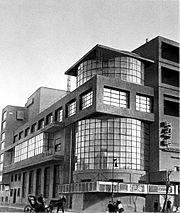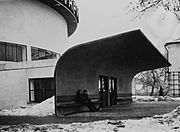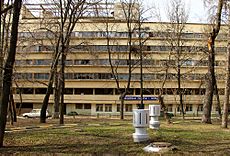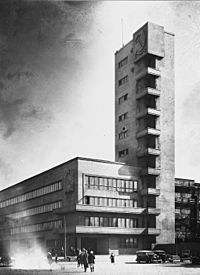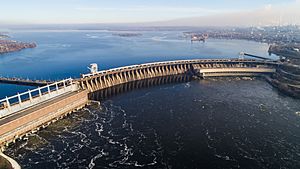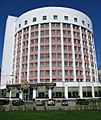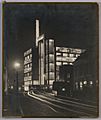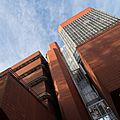Constructivist architecture facts for kids
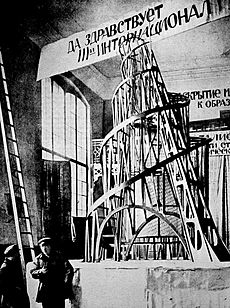
Constructivist architecture was a special style of modern architecture. It became popular in the Soviet Union during the 1920s and early 1930s. This style was very simple and used basic shapes. It wanted to show the spirit of modern industrial society and city life.
Constructivist buildings avoided fancy decorations. Instead, they focused on using industrial materials like steel and glass. These designs mixed new technology and engineering with a clear communist social goal. Even though there were different groups within the movement, they created many new and important buildings. This style was popular until about 1932. It has greatly influenced how buildings are designed even today.
Contents
- What is Constructivist Architecture?
- A New Way to Design Buildings
- ASNOVA and Rationalism: Smart Designs
- OSA: Building for Everyone
- Daily Life and Dream Buildings
- City Planning: Building New Towns
- The End of Constructivism
- What Constructivism Left Behind
- Gallery
- Constructivist Buildings in the Former USSR
- See also
What is Constructivist Architecture?
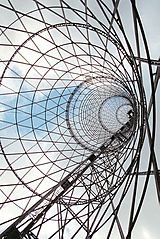
Constructivist architecture grew from a bigger art movement called Constructivism. This art style came from Russian Futurism. Early Constructivist art used cubist ideas to make abstract, non-objective "constructions." These often had moving parts.
After the Russian Revolution of 1917, artists wanted to help the new society. They focused on new social needs and industrial tasks. Two main ideas appeared. One focused on space and rhythm, led by Antoine Pevsner and Naum Gabo. The other group, called Productivists, wanted art to be part of industrial production. Important Productivists were Alexander Rodchenko, Varvara Stepanova, and Vladimir Tatlin.
In 1922, Pevsner and Gabo left the country. The movement then became more focused on practical uses for society. The Productivists gained support and became very important. They influenced the architectural group O.S.A..
A New Way to Design Buildings
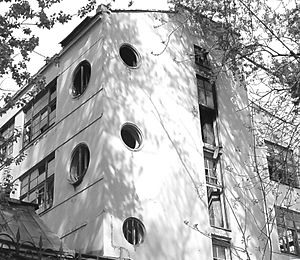
The first and most famous Constructivist building idea was for the headquarters of the Comintern. This was proposed in 1919 by Vladimir Tatlin for Saint Petersburg. It is often called Tatlin's Tower. This tower was never built.
However, its design used glass and steel. Its modern ideas and political meaning set the stage for other projects in the 1920s. The moving parts inside the tower were meant to show revolution.
Another early Constructivist idea was the Lenin Tribune by El Lissitzky (1920). This was a speaker's stand that could move. During the Russian Civil War, artists like Kazimir Malevich and Lissitzky designed projects. They mixed abstract art with useful goals. They created ideas for perfect Constructivist cities. Examples include El Lissitzky's Prounen-Raum and Gustav Klutsis's 'Dynamic City' (1919).
ASNOVA and Rationalism: Smart Designs
After the Russian Civil War, the USSR was very poor. It could not afford many big new buildings. Still, the Soviet art school Vkhutemas started an architecture section in 1921. It was led by Nikolai Ladovsky and called ASNOVA.
Their teaching methods were both practical and imaginative. They explored new shapes and forms. An example is Simbirchev's restaurant, which was made of glass and seemed to hang in the air. Architects like El Lissitzky, Konstantin Melnikov, and Berthold Lubetkin were part of ASNOVA.
From 1923 to 1935, projects like Lissitzky and Mart Stam's horizontal skyscrapers showed how original this group was. Konstantin Melnikov designed the Soviet Pavilion for the Paris Exposition in 1925. This building helped make the new style famous. Its rooms were designed by Rodchenko and had sharp, mechanical shapes.
The film Aelita also showed Constructivist ideas. Its sets had angular, geometric designs by Aleksandra Ekster. Early modern buildings for the new consumerism included the Mosselprom department store (1924). The Vesnin brothers' Mostorg store was built three years later. Modern offices for newspapers were also popular, like the Izvestia headquarters (1926–7) by Grigori Barkhin.
OSA: Building for Everyone
A more technical Constructivist style appeared with the 1923/4 glass office project. This was for Leningradskaya Pravda by the Vesnin brothers. In 1925, the OSA Group was started by Alexander Vesnin and Moisei Ginzburg. This group was like the Functionalism style in Germany.
OSA focused on housing, especially collective housing. These special buildings, called dom kommuny, were meant to replace old 19th-century homes. The idea was to create a "social condenser." This meant designing buildings that would help people live a new, shared life. Vladimir Lenin wrote in 1919 that true communism would begin by changing household chores into a "vast socialist household."
Some collective housing projects were built. These included Ivan Nikolaev's Communal House of the Textile Institute (Moscow, 1929–1931). Ginzburg designed the Moscow Gosstrakh flats and his famous Narkomfin Building. Constructivist flats were built in cities like Kharkiv, Moscow, and Leningrad.
Ginzburg believed that building for the new society was different from the old. He said Constructivists focused on how daily life was changing. Their goal was to work with people to create a new way of living. OSA published a magazine called SA (Contemporary Architecture) from 1926 to 1930. Ladovsky also designed his own type of mass housing, finishing a Moscow apartment block in 1929.
Daily Life and Dream Buildings
The new Constructivist forms started to represent the idea of a new daily life in the Soviet Union. Large state buildings were constructed, like the Gosprom complex in Kharkiv (1926–8). This was one of the biggest Modernist buildings of the 1920s. Other important works included the Moscow Planetarium (1929) by Mikhail Barsch and Mikhail Sinyavsky.
The new style became so popular that even traditional architects started using it. Examples include Ivan Zholtovsky's MOGES power station (1926) and Alexey Shchusev's Narkomzem offices in Moscow. The Shukhov Tower by engineer Vladimir Shukhov was also seen as a very modern work. Shukhov also worked with Konstantin Melnikov on bus garages. Many of these buildings appear in Sergei Eisenstein's film The General Line.
A main goal of Constructivists was to bring modern art into everyday life. From 1927, they designed Workers' Clubs. These were community centers usually built in factory areas. Famous examples include the Kauchuk, Svoboda, and Rusakov clubs by Konstantin Melnikov. The club of the Likachev works was designed by the Vesnin brothers. Ilya Golosov designed the Zuev Workers' Club.
At the same time, very imaginative projects were designed. Ivan Leonidov's Lenin Institute was a high-tech work. It included a huge library, a planetarium, and a dome, all connected by a monorail. Georgy Krutikov designed a 'Flying City,' which was meant to be a serious idea for homes in the air. Melnikov House and his Bakhmetevsky Bus Garage show the mix of individual ideas and practical uses in Constructivism.
There were also ideas for Suprematist skyscrapers called 'planits' by Kazimir Malevich. Yakov Chernikhov created books of experimental designs, like Architectural Fantasies (1933). He was known as 'the Soviet Piranesi' for his wild ideas.
City Planning: Building New Towns
Even though many Constructivist ideas for cities were grand, few were actually built. However, the Narvskaya Zastava area in Leningrad became a center for Constructivism. Starting in 1925, architects like A. Gegello and Alexander Nikolsky designed communal housing there. Public buildings like the Kirov Town Hall by Noi Trotsky (1932–4) were also built.
Many Constructivists hoped their ideas would come true during the 'Cultural Revolution.' At this time, Constructivists were split. Some were "urbanists" who liked big cities. Others were "disurbanists" who preferred a garden city or linear city model. The Linear City idea was promoted by Nikolay Milyutin in his book Sozgorod (1930).
Some architects from Germany, fleeing Nazism, also worked in the Soviet Union. These included Ernst May and Hannes Meyer. Le Corbusier's city planning ideas were also popular for a short time. He designed the Tsentrosoyuz government building with Nikolai Kolli. Another famous modernist, Erich Mendelsohn, designed Leningrad's Red Banner Textile Factory. He also helped make Constructivism known with his book Russland, Europa, Amerika.
A big project from the Five Year Plan with Constructivist input was DnieproGES, designed by Viktor Vesnin and others. El Lissitzky also helped spread the style abroad with his 1930 book The Reconstruction of Architecture in Russia.
The End of Constructivism
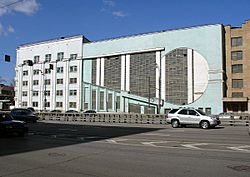
In 1932, there was a competition for the Palace of the Soviets. This was a huge project meant to be as grand as the Empire State Building. All the main Constructivists, along with famous architects like Walter Gropius and Le Corbusier, submitted designs.
However, this time also saw a lot of criticism against Modernism. It was hard to keep this style going in a country that was still mostly farming. People also said the style just copied technology without using truly new building methods. The winning design by Boris Iofan marked the start of Stalinist Architecture. This new style mixed historical designs.

Buildings like the Narkomfin were designed to change daily life in the 1920s. They aimed for shared facilities and equality. But these ideas became less popular as Stalinism brought back traditional family values. Old world styles were also revived. The Moscow Metro helped make the idea of 'workers' palaces' popular.
By the late 1920s, Constructivism was the main architectural style in the country. Many buildings from this time still stand today. For a few years, some buildings were designed in a mixed style called Postconstructivism.
After this short period, a Neo-Classical style became completely dominant until 1955. Constructivist ideas were still used in industrial buildings. But they disappeared from city projects. The last few Constructivist buildings were finished between 1933 and 1935. Examples include Panteleimon Golosov's Pravda building (1935) and Ladovsky's metro entrances.
What Constructivism Left Behind
Constructivism was linked to politics and was replaced by Stalinist architecture. Because of this, its dynamic forms were not part of the calmer International Style. However, in the 1960s, Constructivism gained new appreciation. Its experimental ideas influenced later buildings.
Outside the USSR, Constructivism was seen as a different, more radical modern style. Its influence can be seen in architects like Team 10 and Kenzō Tange. It also influenced much of Brutalist architecture. The way Constructivists tried to mix modern art with daily life is similar to the ideas of the Situationists.
High Tech architecture also owes a lot to Constructivism. A clear example is Richard Rogers' Lloyd's building. Zaha Hadid's early designs were based on Malevich's Architektons. The influence of Chernikhov is clear in her drawings. Deconstructivism also shows the energy of Constructivism, but without the social goals.
Sadly, many original Constructivist buildings are not well cared for. Some are even in danger of being torn down.
Gallery
-
Melnikov House in Moscow.
-
Hotel Iset (Yekaterinburg, Chekists Village)
-
De Volharding, mixed-use building by Jan Buijs (The Hague, 1927–28)
-
Maxim Gorky Theatre, Rostov-na-Donu, 1935
-
Regional administration building, 1930–1932. Novosibirsk.
-
Krasny Prospekt 11. Novosibirsk
-
Derzhprom building in Kharkiv, 1925–1928
-
Club of Slovak Artists, Bratislava, Slovakia, 1926
-
Former hospital Bezručova by Alois Balán and Jiří Grossmann, Bratislava (Slovakia), 1939
-
University of Leicester Engineering Building by James Stirling (1963)
Constructivist Buildings in the Former USSR
Moscow
- Mosselprom building (1925) by Nikolai Strukov
- Bakhmetevsky Bus Garage (1927) by Konstantin Melnikov and Vladimir Shukhov
- Kauchuk Factory Club (1929) by Konstantin Melnikov
- Svoboda Factory Club (1929) by Konstantin Melnikov
- Novo-Ryazanskaya Street Garage (1929) by Konstantin Melnikov and Vladimir Shukhov
- Melnikov House (1929) by Konstantin Melnikov
- Narkomfin Building (1930) by Moisei Ginzburg and Ignaty Milinis
- Rusakov Workers' Club (1929) by Konstantin Melnikov
- Zuev Workers' Club (1929) by Ilya Golosov
- Tsentrosoyuz building (1936) by Le Corbusier and Nikolai Kolli
- Gosplan Garage (1936) by Konstantin Melnikov
- ZiL House of Culture (1937) by Vesnin brothers
Leningrad (Saint-Petersburg)
- Stadium for metal workers "Red Profintern" (1927) by Aleksandr Nikolsky and Lazar Khidekel
- Red Flag Textile Factory (1929) by Erich Mendelsohn
- Bolshoy Dom in Leningrad (1932) by Noi Trotsky, Alexander Gegello and Andrey Ol.
- Kirov District House of Soviets (1935) by Noi Trotsky
- Moscow District House of Soviets (1935) by Igor Fomin, Igor Daugul and Boris Serebrovsky
- 1st House of Lensovet (1934) by Evgeny Levinson and Igor Fomin
- Club for the shipyard workers in Leningrad. by Aleksandr Nikolsky and Lazar Khidekel
- Pumping station. Vasilyeostrovskaya pumping station near the harbor in Leningrad. Construction (1929-1930) by Lazar Khidekel
- Dubrovskiy Electro Power Station S.M. Kirov and Residential settlement Doubrovskaya HPP. Planning and construction of the first in the Soviet Union socialist town - sotsrogodok for workers and specialists (1931-1933) by Lazar Khidekel
Minsk
- Government House, Minsk (and similar Oblispolkom in Mogilev) by Iosif Langbard
Kharkiv
- Derzhprom (1928) by Sergey Serafimov, Samuil Kravets and Marc Folger
- House of Projects (1932) by Sergey Serafimov and Maria Sandberg-Serafimova
- Post Office (1929) by Arkady Mordvinov
Zaporizhia
- DnieproGES (1932) by Viktor Vesnin and Nikolai Kolli
Sverdlovsk (Ekaterinburg)
- Builders Club (1929) by Yakov Kornfeld
- House of Printing (1930) by Vladimir Sigov
- 'Gorodok chekistov' (1933) by Ivan Antonov, Veniamin Sokolov and Arseny Tumbasov
- House of Communications (1933) by Kasyan Solomonov
Kuybyshev (Samara)
- House of Red Army (1930) by Pyotr Scherbachov
- Factory kitchen (1933) by Evgenya Maksimova
- House of Industry (1933) by Vasily Sukhov
Novosibirsk
- Prombank Dormitory (1927) by I. A. Burlakov
- Polyclinic No. 1 (1928) by P. Shyokin
- Business House (1928) by D. F. Fridman and I. A. Burlakov
- Aeroflot House (1930s)
- State Bank (1930) by Andrey Kryachkov
- Rabochaya Pyatiletka (1930)
- Krayispolkom (Regional Administration Building, 1932) by Boris Gordeev and Sergey Turgenev
- Soyuzzoloto House (1932) by Boris Gordeyev and A. I. Bobrov
- NKVD House (Serebrennikovskaya Street 16) (1932) by Ivan Voronov and Boris Gordeyev
- Novosibirsk Chemical Engineering Technical School (1932) by A. I. Bobrov
- Kuzbassugol Building Complex (1933) by D. A. Ageyev, B. A. Bitkin and Boris Gordeyev
- House of Kraysnabsbyt (1934) by Boris Gordeev and Sergey Turgenev
- Dinamo Residential Complex (1936) by Boris Gordeyev, S. P. Turgenev, V. N. Nikitin
- NKVD House (Serebrennikovskaya Street 23) (1936) by Sergey Turgenev, Ivan Voronov and Boris Gordeyev
Non-implemented projects
- Palace of the Soviets Project
- Tatlin's Tower project by Vladimir Tatlin
- Narkomtiazhprom Project
See also
 In Spanish: Arquitectura constructivista para niños
In Spanish: Arquitectura constructivista para niños


